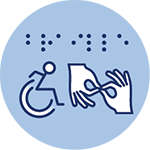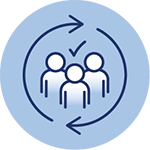The goal of this policy is to empower and elevate the lives of persons with disabilities in partner countries by supporting USAID and our partners to recognize, respect, value, meaningfully engage, include, and be intentional in supporting persons with disabilities and their representative organizations to benefit equitably from our work as equal partners.
EXECUTIVE SUMMARY
There are more than 1 .3 billion persons with disabilities globally—or approximately 16 percent of the global population—with nearly 80 percent of persons with disabilities living in low- and middle-income countries (LMICs) and 240 million children with disabilities worldwide. In 1997, USAID became one of the first bilateral development agencies in the world to adopt a policy on disability to guide the Agency’s efforts toward disability inclusion. Now, USAID has convened stakeholders, development practitioners, and community members around the world to inform an updated policy aimed at further advancing disability-inclusive development. This 2024 “Nothing Without Us: USAID Disability Policy” responds to stakeholder feedback, updates promising practices, places the Agency’s work within the current global context, and situates USAID to fulfill its long-standing commitment to nondiscrimination and inclusion of persons with disabilities in society on an equitable basis with others. The policy also positions USAID to partner with persons with disabilities in meeting the myriad challenges and opportunities of the 21st century.
The goal of this policy is to advance empowerment and elevate the lives of persons with disabilities in partner countries by supporting USAID and our partners to recognize, respect, value, meaningfully engage, include, and be intentional in supporting persons with disabilities and their representative organizations to benefit equitably from our work as equal partners. Intentional and meaningful inclusion of persons with disabilities across all areas of USAID’s work is key to countries meeting their development goals and potential. Moreover, meaningful and intentional disability inclusion is fundamental to making development and humanitarian assistance effective and cost-effective.
To achieve the objectives of this policy, USAID will uphold the following seven operating principles:







To achieve the vision, goal, and objectives of this policy, USAID has identified the following key approaches and opportunities to promote effective implementation and support a systematic change-management process to furthering USAID’s disability-inclusion work
- Engagement and Communications
- A Disability-Inclusive Approach to Locally Led Development
- Partnering for Success
- Communications
- Foundations for Operational Success
- Twin-Track Approach
- Budgeting for Success
- Leveraging Principles of Universal Design (UD)
- Approaching Our Work Across the Life Course
- Systems Strengthening
- Inclusive Acquisition and Assistance
- Living Our Values
- Supported and Representative Staffing
- Leading Through Development Diplomacy: Advancing Progress Beyond Programs
- Commitment to Continued Improvement
Recognizing that all of USAID’s programming and interventions are relevant to persons with disabilities, Annex 1 provides a brief overview of the situation of persons with disabilities, as well as examples of promising approaches for disability- inclusive programming across the broad range of sectors of USAID’s work.
INTRODUCTION
In 1997, USAID became one of the first bilateral development agencies in the world to adopt a policy on disability to guide the Agency’s efforts toward disability inclusion. Since then, understanding of the global situation of persons with disabilities has deepened, persons with disabilities have forged a truly international cross-disability advocacy movement, and the policy environment in which USAID operates has expanded to include the first international human rights treaty focused on the rights of persons with disabilities and a global development agenda that explicitly includes persons with disabilities. The 2024 “Nothing Without Us: USAID Disability Policy” places USAID’s work within this new global context; situates USAID to fulfill its long-standing commitment to nondiscrimination and inclusion of persons with disabilities in society on an equitable basis with others; informs the development of technical guidance documents specific to USAID’s programming and assistance interventions; and positions USAID to partner with persons with disabilities in meeting the challenges and opportunities of the 21st century.
Disability discrimination and stigma can lead to persons with disabilities being denied access to all areas of life—including education, employment and economic empowerment, transportation, housing, health care, sports and recreation, religion, culture, justice, and participation in political and public life—on an equitable basis with others. Lack of support for community living leaves too many persons with disabilities around the world living in institutions and at risk of abuse, neglect, and significant mental and physical harm or worse.1 Societal exclusion not only disadvantages persons with disabilities and can lead to human rights abuses, it also deprives countries of the unique economic, social, cultural, and interpersonal contributions of persons with disabilities across all areas of life and at all levels of society.
Although there is a continued need for improved data collection with respect to persons with disabilities, the available data paint a vivid picture of the types and impacts of pervasive stigma and discrimination experienced by persons with disabilities. For example, some persons with disabilities die up to 20 years earlier than non-disabled persons due to inequitable access to health care systems and services by persons with disabilities.2 On average, only one in three persons with disabilities is employed, and they are two times less likely to be employed than non-disabled persons.3 Compared to non-disabled children and youth, children and youth with disabilities are 49 percent more likely to have never attended school, 47 percent more likely to be out of primary school, 33 percent more likely to be out of lower-secondary school, and 27 percent more likely to be out of upper-secondary school.4 Children with disabilities are also two to three times more likely to be malnourished and twice as likely to die from malnutrition as their non-disabled peers.5 Exposure to violence—including gender-based violence (GBV)—is higher for persons with disabilities than their non-disabled peers.6 The disproportionately high levels of poverty, exposure to violence, lack of access to services, and underrepresentation in political and public life are particularly acute7 for the estimated 700 million women and girls with disabilities globally.8 LGBTQI+ persons with disabilities face multiple, intersecting layers of discrimination and stigma as well as barriers to societal inclusion. They may face a lack of community or family support or receive support that is conditional on not freely expressing their sexuality and/or gender identity. Emerging technologies such as artificial intelligence (AI) have the potential to positively impact persons with disabilities, including by mitigating and counteracting some of the inequities experienced by persons with disabilities. However, the encoding of ableist norms and assumptions into some AI applications, and lack of meaningful engagement of persons with disabilities in the development of these technologies, has generated concerns about discrimination against persons with disabilities in AI and related contexts.9
Disparate outcomes for persons with disabilities should not be considered inevitable. Intentional and meaningful inclusion of persons with disabilities across all areas of USAID’s work is essential so countries can meet their development goals and individual citizens can reach their full potential. Disability-inclusive development and humanitarian assistance is more effective because it supports peaceful and prosperous societies in which persons with disabilities enjoy the rights, agency, access, influence, and opportunities to pursue their life goals on an equitable basis with others. Disability inclusion is also more cost-effective, especially when incorporated from the outset. For example, when accessibility features are incorporated into new construction, they typically account for less than 1 percent of the overall cost of construction, compared to much higher costs associated with retrofitting.10
USAID’s approach to disability inclusion is aligned with and informed by the following key legal and policy frameworks.
- Convention on the Rights of Persons with Disabilities (CRPD): Adopted in 2006 and establishing definitively that disability rights are human rights, the CRPD situates existing human rights within the disability context, ending what has been referred to as the “invisibility” of persons with disabilities within the international human rights architecture. As the treaty approaches near universal ratification, it is important to note that all but a diminishing handful of countries in which USAID works are parties to the CRPD.11 Among those state parties, the CRPD is catalyzing adoption of national legislation and policies to respect, protect, and fulfill the human rights of persons with disabilities. It is important the Agency’s interventions complement and support conditions consistent with effective implementation of the CRPD by those countries with whom USAID works that are state parties to the treaty. The CRPD is also a key reference in adopting a rights-based approach to USAID’s work that is inclusive of persons with disabilities.
- 2030 Sustainable Development Goals (SDGs): The 17 goals and 169 associated development targets for eradicating poverty, adopted by all United Nations Member States in 2015, build upon the previous Millennium Development Goals (MDGs). Unlike the MDGs, the SDGs and their indicators explicitly reference persons with disabilities, including with respect to goals 4, 8, 10, 11, 16, and 17, which cover important issues such as education; employment; inequality; inclusive, safe, resilient, and sustainable cities and human settlements; representation in elected positions; and strengthened data, monitoring, and accountability. Implementation of the SDGs are animated by three principles: human rights-based approach; leave no one behind; and gender equality and women’s empowerment.
- U.S. Legislation: As one of the first countries in the world to adopt legislation comprehensively prohibiting discrimination on the basis of disability through the 1990 Americans with Disabilities Act (ADA, later updated by the Americans with Disabilities Act Amendments Act of 2008), the United States has a robust and extensive framework of federal civil rights laws and regulations that provide equal opportunity protections for persons with disabilities. USAID seeks to comply with its legal obligations pursuant to those laws (e.g., laws addressing equal employment opportunity for persons with disabilities, provision of reasonable accommodations, accessibility of electronic and information technology, etc.) and incorporates as a matter of policy relevant U.S. standards into Agency policies (e.g., prohibiting discrimination consistent with the 1973 Rehabilitation Act, extending the principles of the ADA and the 1968 Architectural Barriers Act to USAID-financed assistance for new or renovation construction). Mindful of the need to respect local contexts and approaches, U.S. laws and regulations protecting the rights of persons with disabilities also offer helpful principles and methods to inform rights-based programmatic approaches to USAID’s work with respect to persons with disabilities.
- USAID Policies and Strategies: The Disability Policy informs and is informed by the State Department and USAID Joint Strategic Plan and USAID Policy Framework (both of which reference persons with disabilities as among the marginalized groups to include and support in our work to advance equity) and numerous Agency policies and strategies.12 These policies and strategies address technical, operational, and communication aspects of programming and embody USAID’s commitment to nondiscrimination and inclusive development, consistent with the guiding principles of diversity, equity, inclusion, and accessibility. Many of these policies and strategies expressly reference persons with disabilities and the importance of fostering accessibility for and inclusion of persons with disabilities, including in sector-specific contexts.
Disability only becomes a tragedy when society fails to provide the things we need to lead our lives—job opportunities or barrier-free buildings, for example. It is not a tragedy to me that I’m living in a wheelchair.13
—JUDITH HEUMANN, AMERICAN DISABILITY RIGHTS ADVOCATE, FORMER U .S . DEPARTMENT OF STATE SPECIAL ADVISOR FOR INTERNATIONAL DISABILITY RIGHTS (2010–2017)
Footnotes
Numerous organizations, including the U.S. Department of State (through the Country Reports on Human Rights Practices) and myriad human rights nongovernmental organizations, report with regularity on the situation of persons with disabilities around the world. See, e.g., Human Rights Watch, “ ‘They Stay Until They Die’: A Lifetime of Isolation and Neglect in Institutions for People with Disabilities in Brazil” (2018), “ ‘When Will I Get to Go Home?’ Abuses and Discrimination Against Children in Institutions and Lack of Access to Quality Inclusive Education in Armenia” (2017), “ ‘It is My Dream to Leave This Place’: Children with Disabilities in Serbian Institutions” (2016), and “Living in Hell: Abuses Against People with Psychosocial Disabilities in Indonesia” (2016). Back to text
World Health Organization (WHO), “Global Report on Health Equity for Persons with Disabilities” (2022). Back to text
International Labour Organization (ILO), “International Day of Persons with Disabilities: How Disability Affects Labour Market Outcomes” (2022). Back to text
UNICEF, “Nearly 240 Million Children with Disabilities Around the World, UNICEF’s Most Comprehensive Statistical Analysis Finds” (2021). Back to text
The Missing Billion Initiative and Clinton Health Access Initiative, “Reimagining Health Systems that Expect, Accept and Connect 1 Billion People with Disabilities” (2022). Back to text
UN Population Fund (UNFPA), “Young Persons with Disabilities: Global Study on Ending Gender-Based Violence, and Realising Sexual and Reproductive Health and Rights” (2018). Back to text
UN Department of Economic and Social Affairs (UNDESA), “Disability and Development Report: Realizing the Sustainable Development Goals by, for and with Persons with Disabilities” (2018). Back to text
UN Women. “ ‘They Call Me by My Name’: A Synthesis Review of the United Nations Trust Fund to End Violence Against Women’s Special Window on Ending Violence Against Women and Girls with Disabilities” (2023). Back to text
UN Office of the High Commissioner for Human Rights (OHCHR), “Report of the Special Rapporteur on the Rights of Persons with Disabilities on Artificial Intelligence and the Rights of Persons with Disabilities” (2021). Back to text
World Bank, “Education for All: The Cost of Accessibility” (2005). Back to text
The United States became a signatory to the CRPD in July 2009, committing to upholding the object and purpose of the treaty and consistent with the strong guarantees of nondiscrimination and equality of access and opportunity for persons with disabilities in existing U.S. law. As of the time of adoption of this policy, the United States has not yet ratified the CRPD. Back to text
For a complete current listing of policies and strategies, please refer to the USAID Policy Registry (www.usaid.gov/policy). Back to text
Joseph Shapiro, “Activist Judy Heumann Led a Reimagining of What it Means to be Disabled,” National Public Radio (2023). Back to text
